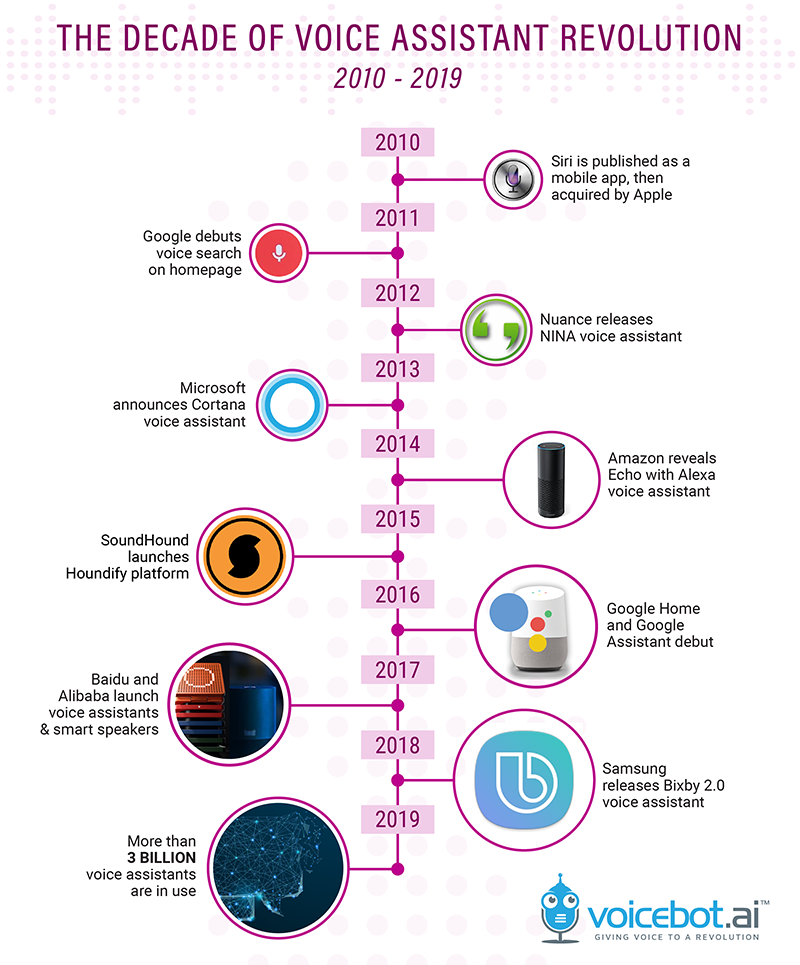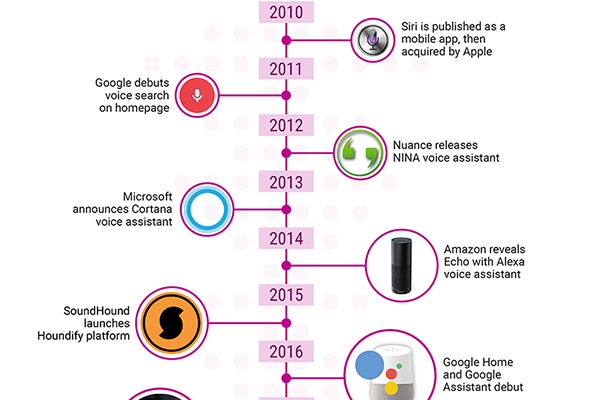The Decade of Voice Assistant Revolution
The last 10 years have utterly transformed how people think about voice technology. From limited uses in just a few outlets, voice assistants are now integrating into every part of people’s lives. To encapsulate everything that has happened in ten years, we’ve picked a notable event from each year of the last decade to highlight and show how they marked a milestone in the way voice assistants have evolved and spread. (You can also see a more detailed timeline since 1961 here)

2010 – Siri is published as a mobile app, then acquired by Apple
Siri began life as an independent voice assistant, a mobile app for iPhones. Apple saw potential in Siri and snapped up the company and its creation in 2010. Starting with the iPhone 4S, Apple integrated Siri as its voice assistant into every voice-capable product, including its current ecosystem of smart speakers and wearable technology. Because of its early spread through iPhones, Siri became the first voice assistant for a huge number of people, setting expectations and ideas about how voice assistants should operate ever since. Siri has changed and expanded its abilities enormously in the course of the decade, but Apple is still keeping tight control over what the voice assistant can do, with a much more limited list of third-party developers compared to its main rivals. Still, there’s no question that Siri set the standard in many ways for what was to come.
2011 – Google debuts voice search on the homepage
Google started testing voice search technology on mobile devices in the 2000s, but it wasn’t until 2011 that Google.com added a little microphone button for searching by voice. Applying voice technology to the massive power of Google’s search engine marked an important step for the industry. Even though voice search was limited to the Google Chrome browser, suddenly a huge market had a chance to try out interacting with a website using their voice. It would be years before Google Assistant debuted, but the seeds were planted. Google’s desktop voice search also laid out a template for other websites to follow.
2012 – Nuance releases NINA voice assistant
Nuance has been a major player in the voice technology space for a long time, including powering Siri’s voice recognition for a time. NINA (Nuance Intelligent Virtual Assistant) at first seemed like the way it would stake a claim in the voice assistant competition, applying the years it had spent building voice software engines to outcompete other companies. Nina did not end up taking the consumer voice assistant world by storm, but Nuance is continuing to transform the industry. Nina is now a digital assistant used by businesses to interact with customers. Nuance diversified and specialized the same technology into a whole host of verticals, including a virtual assistant to help doctors handle administrative duties and paperwork. The company’s success led to an entire spin-off company, Cerence, devoted to developing voice assistants for automobiles.
2013 – Microsoft announces Cortana voice assistant
Microsoft’s entry into the voice assistant arena in 2013 started off very strong. Cortana would become part of Windows, Xbox, and other Microsoft creations, and take a spot in products built by other brands too. At the end of the decade, however, Cortana has a very different shape as Microsoft ends Cortana’s consumer-facing features and realigns it purely for business and enterprise efforts. That Microsoft would decide it couldn’t compete for the mass market in this technology would have been hard to imagine in 2013, but Cortana’s next decade will be in offices.
2014 – Amazon reveals Echo with Alexa voice assistant
Amazon’s dominance in e-commerce and cloud computing overshadowed its attempts to build consumer technology until the company announced a smart speaker with its own voice assistant named for the Library of Alexandria. Alexa arguably is the most influential voice assistant around now, leaping ahead of Siri or Cortana to the point where Alexa is often used as a generic term for any voice assistant. Amazon is aggressive in pushing the voice assistant into an ever-growing array of smart speakers and other products, from wearables to cars, trying and discarding ideas when they don’t generate enough interest. The Alexa marketplace may be the most significant contribution of Alexa to the voice assistant space. There are now more than 100,000 skills on the market, many with premium options that earn developers money. Despite growing pains, Alexa is well-positioned for the decade to come.
2015 – SoundHound launches Houndify platform
The average consumer might associate SoundHound with a music identification app, but the company’s Houndify platform is powering more and more branded voice assistants for companies who want their name on one without building their own. The $100 million in funding the company raised not long after Houndify came out has fueled its rapid growth and shown how there’s plenty of room for competition in voice technology, regardless of the name used to summon the virtual assistant.
2016 – Google Home and Google Assistant debut
Google took everything it had learned from its voice experiments into creating Google Assistant, which challenges Alexa, at least in the U.S., for supremacy as a voice assistant option. Often compared to Amazon’s creations, Google Home and Google Assistant offer many of the same features, but with the integration into Google’s larger tech ecosystem, such as Android phones as an additional lure. That became particularly true in the years after its debut when Google bought Nest and started creating a smart home network in earnest. While not neglecting the other aspects of the voice assistant space, Google’s emphasis on making Google Assistant an omnipresent part of people’s lives has made it increasingly difficult to have an ecumenical smart home and ensured the debate about which voice assistant to use will heat up more in the coming decade.
2017 – Baidu and Alibaba launch voice assistants and smart speakers
U.S. tech companies eager for a global presence for their voice assistants have diligently worked to build a presence in Asia, but in 2017 the competition became a lot stiffer. Chinese tech giants Baidu and Alibaba both came out with their own smart speakers, powered by their own voice assistants that year. Other Asian tech firms followed, but Baidu and Alibaba’s developments meant that the voice assistant market would not be dominated everywhere by Amazon, Google or Apple. The differences in how the Chinese voice assistants operate also means there’s no universal baseline for voice assistants, even as they all inevitably imitate each other’s more popular features.
2018 – Samsung releases Bixby 2.0 voice assistant
Samsung had attempted to carve a space in the voice assistant market in 2017 when it debuted Bixby. It only took six months for the company to decide to revamp it entirely. Bixby 2.0 didn’t just solve some of the problems with the first iteration, it also refocused the voice assistant on being more flexible for developers and more personalized for users than it was originally. Samsung is a powerful brand name, but it remains to be seen if Bixby and its Capsules can open up the competition among voice assistants, especially in the U.S., in the decade ahead.
2019 – More than 3 billion voice assistants are in use
There are billions of voice assistants in use today. Juniper Research pegged the number at 3.25 billion in February, with expectations of hitting 8 billion in 2023. Those billions speak to the ubiquity of voice assistants today. Smart speakers and smartphones may be the most common way to interact with them, but televisions, cars, office equipment, and even clothing can all offer access to the voice of a powerful AI. The ways people use voice assistants are expanding almost as quickly as the options for interacting with them. We’ve reached the point where voice assistants are as much a facet of tech as they are something separate to consider. The stilted orders to make a phone call repeated until understood, are now a casual conversation to order groceries, turn off the lights, and start the car.
With ubiquity comes heightened scrutiny. The last year has seen heated debates over privacy with regard to voice assistants and issues of security and safety are not going to fade away. What might seem like relentless forward progress holds plenty of potential pitfalls for voice assistant developers as people become more comfortable with the technology and thus better able to question its implications. The next decade of voice assistants may include as much change as the last ten years, but any attempt to predict it exactly may as well be the Magic 8-Ball voice app offered by most voice assistant platforms.
Follow @voicebotai Follow @erichschwartz









